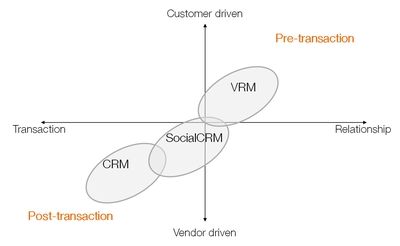My thinking out loud about what came to be called VRM began with The Intention Economy at Linux Journal, which I posted from a seat amidst the audience at the 2006 eTech in San Diego. The money ‘graphs:
The Intention Economy grows around buyers, not sellers. It leverages the simple fact that buyers are the first source of money, and that they come ready-made. You don’t need advertising to make them.
The Intention Economy is about markets, not marketing. You don’t need marketing to make Intention Markets.
The Intention Economy is built around truly open markets, not a collection of silos. In The Intention Economy, customers don’t have to fly from silo to silo, like a bees from flower to flower, collecting deal info (and unavoidable hype) like so much pollen. In The Intention Economy, the buyer notifies the market of the intent to buy, and sellers compete for the buyer’s purchase. Simple as that.
The Intention Economy is built around more than transactions. Conversations matter. So do relationships. So do reputation, authority and respect. Those virtues, however, are earned by sellers (as well as buyers) and not just “branded” by sellers on the minds of buyers like the symbols of ranchers burned on the hides of cattle.
The Intention Economy is about buyers finding sellers, not sellers finding (or “capturing”) buyers.
In The Intention Economy, a car rental customer should be able to say to the car rental market, “I’ll be skiing in Park City from March 20-25. I want to rent a 4-wheel drive SUV. I belong to Avis Wizard, Budget FastBreak and Hertz 1 Club. I don’t want to pay up front for gas or get any insurance. What can any of you companies do for me?” — and have the sellers compete for the buyer’s business…
I also believe we need to start viewing economies, and markets, from the inside out: from the single buyer toward the surrounding world of sellers. And to start constructing technical solutions to the buyer’s problem of getting what he or she wants from markets, rather than the seller’s problem of getting buyers’ attention.
Now jump forward to David Gillespie‘s 263-slide narrative titled Digital Strangelove (or How I Learned To Stop Worrying And Love The Internet). It doesn’t mention VRM, but it unpacks what’s really happening with The Internet vs. Media (the former subsumes the latter and undermines all silos, among other good things), and it brings up The Intention Economy, by name, on slide 119. Since this is also the title of the book I’m writing, I find this encouraging.
[Later… David responded with this extraordinarily generous post, in which he makes connections to what we’ve both been saying about The Intention Economy.]
Along those same lines we have Chris Messina’s Don’t Make Me a Target, which brings up VRM this way:
Doc Searls calls this consumer-driven leverage VRM or “vendor relationship management”. I’ve been a fan of the idea, but I think it falls down on the last word: management. Big companies are willing to devote thousands and millions of dollars “managing” their customers; individuals are not. But services like Brightkite and Facebook are beginning to change that by enabling us to leverage our real-time, real-world behavior as a gating apparatus, removing the “management” requirement of VRM, and allowing us to “flow with the go”. As we invite these attention brokers into our list of recipients to whom we release increasingly contextualized and precise information about ourselves, we stand to benefit a great deal. And privacy, then, becomes a rational, economic instrument that determines whether a company gets to serve us well (based on knowing us better) or clumsily (as they make presumptions about us through circumstance rather than intentional disclosure).
Well, again we see how VRM is an imperfect name for what the development movement is actually about, which is making customers customers both independent of vendors, and better able to engage with them. I can’t blame Chris for taking VRM’s third name too literally. But I would encourage him, and everybody else, to take a broader view of what we’re trying to do here.
We’ve been saying for some time that much of the money and effort vendors spend “managing” customers is worse than wasted: it’s disliked or outright hated by customers. VRM is about giving customers ways to manage relations (even if those are just simple interactions) with vendors. This doesn’t have to be expensive or complicated. You manage your keys with a ring, and don’t spend millions doing it. VRM won’t work unless it’s key-ring simple. It also won’t work if the only rings you keep in your pocket are ones that vendors give you. The best of these, such as the ones Chris Messina talks about, are steps in the right direction. But at a certain point those steps stop. That point is customer independence, freedom and autonomy. Those are things customers need to have for themselves. Vendors can’t give it to them. That’s why VRM starts with the customer, not the vendor. With his Laws of VRM post, Chris Carfi helps scaffold the concept of VRM with the customer (or, in non-commercial settings, the individual) at the center — as the point of integration, an observation first made by Joe Andrieu.
As David Gillespie points out in his presentation (see slides 37, 38, 50, 55, 66, 73-74…) it’s still early. The Internet is brand new. As I said in Beyond Social Media and Toward Post-Journalism Journalism, the big brands of the Web today (Facebook, Twitter, even Google) are its trilobites and bryzoans. We are in the Net’s paleozoic, not its mesozoic or cenozoic — much less its pleistocene or holocene. The Net feels holocenic to us because now is when we are living and grooving on all the cool new stuff we can do. Still, trust me: it’s early. I’m as impatient as the next geek to get on with it, but it’ll take time. (It pisses me that I’m writing this at age 62, but maybe I wouldn’t be writing it if I were younger.)
So David is right. Intention is the key.
A brief story. Last night on the way home we stopped to pick up some provisions at a big Shaw’s grocery store. We went there because their food selection is enormous, and because have one of their loyalty fobs on my key ring. In fact it’s one of just two on there (the other is Border’s). So we got our cart, gathered a bunch of groceries and went through one of the store’s self-checkout lanes. I hate those things, because something often goes wrong. But my kid loves them. He digs pressing the buttons, scanning the barcodes and bagging the groceries.
Well, something did go wrong. The machine didn’t ask for our Shaw’s card, or if it did we missed the request. After completing the purchase I realized that we got none of the “discounts,” and went to the customer service counter, where we waited about 20 minutes while the helpful people there tried to unscramble what went wrong. During that time I mentioned to one of the service people that I hated the whole loyalty card thing. She said she hated it too, as did other people at the store. Turns out they hated the self-check-out system too. The loyalty system is a big kluge, with double-pricing for nearly everything, slow-downs at check-out, constant de-bugging and other problems. And self-check-out is a constant mess. “We’d be better off getting rid of those things and just adding more express lanes,” she said. I agreed.
In the end they couldn’t figure out what I was due back and instead gave me a gift card with a generous sum on it. Humanity overrode The System.
My point: loyalty programs are screwed up, and so are the constant efforts by sellers to automate the crap out of everything (including relationship as well as transaction), in too many cases offloading customer support to customers themselves. There is a distance beyond which this crap can’t work any more, and we’ve reached it. Beyond that point the market requires self-empowered customers, who will gain the ability to manage relating to multiple sellers in simple and uncomplicated ways that are independent of any seller’s silo, yet able to engage with those sellers in better ways than the sellers can provide with their own systems.
Right now vendors resemble the old AOL vs. Compuserve vs. Prodigy days. Its stil 1989. They’re rolling everything for themselves. What they need is to have the Net brought to them. That’s the customer’s job. Also the mission of VRM.







 a deep and helpful piece by Cliff Gerrish on his
a deep and helpful piece by Cliff Gerrish on his 


